Discharge Characteristics and System Performance of the Ablative Pulsed Plasma Thruster with Different Structural Parameters
Abstract
:1. Introduction
2. Experimental Details
2.1. Vacuum Chamber and Ablative Pulsed Plasma Thruster
2.2. Discharge Parameters Measurement and Estimation Method
2.3. APPT Performance Parameters
3. Results and Discussion
3.1. Effect of Electrode Configuration on Inductance Gradient
3.2. Effect of the Rectangular Electrode Flare Angle on System Performance
3.3. Effect of the Tongue-Shaped Electrode Flare Angle on System Performance
4. Conclusions
Author Contributions
Funding
Data Availability Statement
Conflicts of Interest
References
- Ou, Y.; Wu, J.J.; Zhang, Y.; Li, J.; Tan, S. Theoretical Modeling and Parameter Analysis of Micro-Pulsed Plasma Thruster. Energies 2018, 11, 1146. [Google Scholar] [CrossRef] [Green Version]
- Zhao, Y.Z.; Zhang, Y.; Wu, J.J.; Ou, Y.; Zheng, P. Characteristics of plasma in a novel laser-assisted pulsed plasma thruster. Rev. Mod. Phys. 2019, 3, 3–5. [Google Scholar] [CrossRef]
- Wu, Z.W.; Huang, T.K.; Liu, X.Y.; Ling, W.Y.L.; Wang, N.F.; Ji, L.C. Application and development of the pulsed plasma thruster. Plasma. Sci. Technol. 2020, 22, 131–144. [Google Scholar] [CrossRef]
- Lev, D.; Myers, R.M.; Lemmer, K.M.; Kolbeck, J.; Koizumi, H.; Polzin, K. The technological and commercial expansion of electric propulsion. Acta Astronaut. 2019, 159, 213–227. [Google Scholar] [CrossRef]
- Zhang, R.; Xi, W.X.; Huang, Q. Influence of Different Energy Supply Methods on Performance of Ablative Pulsed Plasma Thrusters. Front. Energy Res. 2021, 9, 752017. [Google Scholar] [CrossRef]
- Wu, Z.; Sun, G.; Huang, T.; Liu, X.; Xie, K.; Wang, N. Optimization of the energy distribution in ablative pulsed plasma thrusters. AIAA J. 2018, 56, 3024–3034. [Google Scholar] [CrossRef]
- Zhang, Z.; Ling, W.Y.L.; Tang, H.b.; Cao, J.B.; Liu, X.Y.; Wang, N.F. A review o Energy Operationf the characterization and optimization of ablative pulsed plasma thrusters. Rev. Mod. Plasma Phys. 2019, 3, 3–5. [Google Scholar] [CrossRef]
- Guman, W.J.; Peko, P.E. Solid Propellant Pulsed Plasma Micro-thruster Studies. In Proceedings of the AIAA the 6th Aerospace Sciences Meeting, New York, NY, USA, 22–24 January 1968. [Google Scholar]
- Ling, Y.L.; Zhang, S.; Liu, X.Y.; Zhang, Z.; Tang, H.B. Spectroscopic plasma emission from a pulsed plasma thruster with asymmetric electrodes. In Proceedings of the AIAA Propulsion and Energy 2019 Forum, Indianapolis, IN, USA, 19–22 August 2019. [Google Scholar]
- Ling, Y.L.; Zhang, S.; Liu, X.Y.; Wang, N.F.; Zhang, Z.; Tang, H.B. A study on asymmetric electrodes for pulsed plasma thrusters. In Proceedings of the 2018 Joint Propulsion Conference, Cincinnati, OH, USA, 9–11 July 2018. [Google Scholar]
- Zhang, Z.; Ren, J.X.; Tang, H.B.; Xu, S.T.; Ling, Y.L.; Cao, J.B. Inter-electrode discharge of an ablative pulsed plasma thruster with asymmetric electrodes. Plasma Sci. Technol. 2018, 27, 124003. [Google Scholar] [CrossRef]
- Zhang, Z.; Ren, J.X.; Tang, H.B.; Ling, Y.L.; Thomas, M.Y. An ablative pulsed plasma thruster with a segmented anode. Plasma Sci. Technol. 2017, 27, 015004. [Google Scholar] [CrossRef]
- Arrington, L.A.; Haag, T.W.; Pencil, E.J.; Meckel, N.J. A Performance Comparison of Pulsed Plasma Thruster Electrode Configurations. In Proceedings of the 25th International Electric Propulsion Conference, Cleveland, OH, USA, 24–28 August 1997. [Google Scholar]
- Pottinger, S.J.; Scharlemann, C.A. Micro Pulsed Plasma Thruster Development. In Proceedings of the 30th International Electric Propulsion Conference, Florence, Italy, 17–20 September 2007. [Google Scholar]
- Palumbo, D.J.; Guman, W.J. Effects of propellant and electrode geometry on pulsed ablative plasma thruster performance. J. Spacecr. Rock. 1976, 13, 163–167. [Google Scholar] [CrossRef]
- Pottinger, S.J.; Krejci, D.; Acharlemann, C.A. Pulsed plasma thruster performance for miniaturized electrode configurations and low energy operation. Acta Astronaut. 2011, 68, 1996–2004. [Google Scholar] [CrossRef]
- Schönherr, T.; Nawaz, A.; Herdrich, G.; Röser, H.P. Influence of the electrode shape on the performance of the pulsed MPD thruster SIMP-LEX. J. Propul. Power 2009, 25, 380–386. [Google Scholar] [CrossRef]
- Nawaz, A.; Albertoni, R.; Auweter-Kurtz, M. Thrust Efficiency Optimization of The Pulsed Plasma Thruster SIMP-LEX. Acta Astronaut. 2010, 67, 440–448. [Google Scholar] [CrossRef]
- Wu, J.J.; Zhang, Y.; Ou, Y. Experimental investigation on the plasma morphology of ablative pulsed plasma thruster with tongue-shaped and flared electrodes. Plasma Sci. Technol. 2020, 22, 094007. [Google Scholar] [CrossRef]
- Ling, W.Y.L.; Schönherr, T.; Koizumi, H. Discharge characteristics of an ablative pulsed plasma thruster with non-volatile liquid propellant. Appl. Phys. Lett. 2017, 111, 1452–1461. [Google Scholar] [CrossRef]
- Koizumi, H.; Furuta, Y.; Komurasaki, K. A Pulsed Plasma Thruster Using Water as the Propellant. In Proceedings of the 40th AIAA/ASME/SAE/ASEE Joint Propulsion Conference, Fort Lauderdale, FL, USA, 11–14 July 2004. [Google Scholar]
- Zhang, Y.; Zhang, D.X.; Wu, J.J.; He, Z.; Zhang, H. A novel laser ablation plasma thruster with electromagnetic acceleration. Acta Astronaut. 2016, 127, 438–447. [Google Scholar] [CrossRef]
- Spanjers, G.G.; Malak, J.B.; Leiweke, R.J.; Spores, R.A. Effect of Propellant Temperature on Efficiency in the Pulsed Plasma Thruster. J. Propul. Power 1998, 14, 545–553. [Google Scholar] [CrossRef] [Green Version]
- Keidar, M.; Boyd, I.D. Antonsen, E.L. Optimization issues for a micropulsed plasma thruster. J. Propul. Power 2006, 22, 48–55. [Google Scholar] [CrossRef]
- Ying, L.; Zhou, J.; Miao, W.B.; Sun, M.B.; Yang, L.; Wu, J.J. Simulation Study for design of pulsed plasma thruster. J. Solid Rocket. Technol. 2010, 33, 419–424. [Google Scholar]
- Markusic, T.E.; Spores, R.A. Spectroscopic emission measurements of a pulsed plasma thruster plume. In Proceedings of the 33rd Joint Propulsion Conference and Exhibit, Seattle, WA, USA, 6–9 July 1997. [Google Scholar]

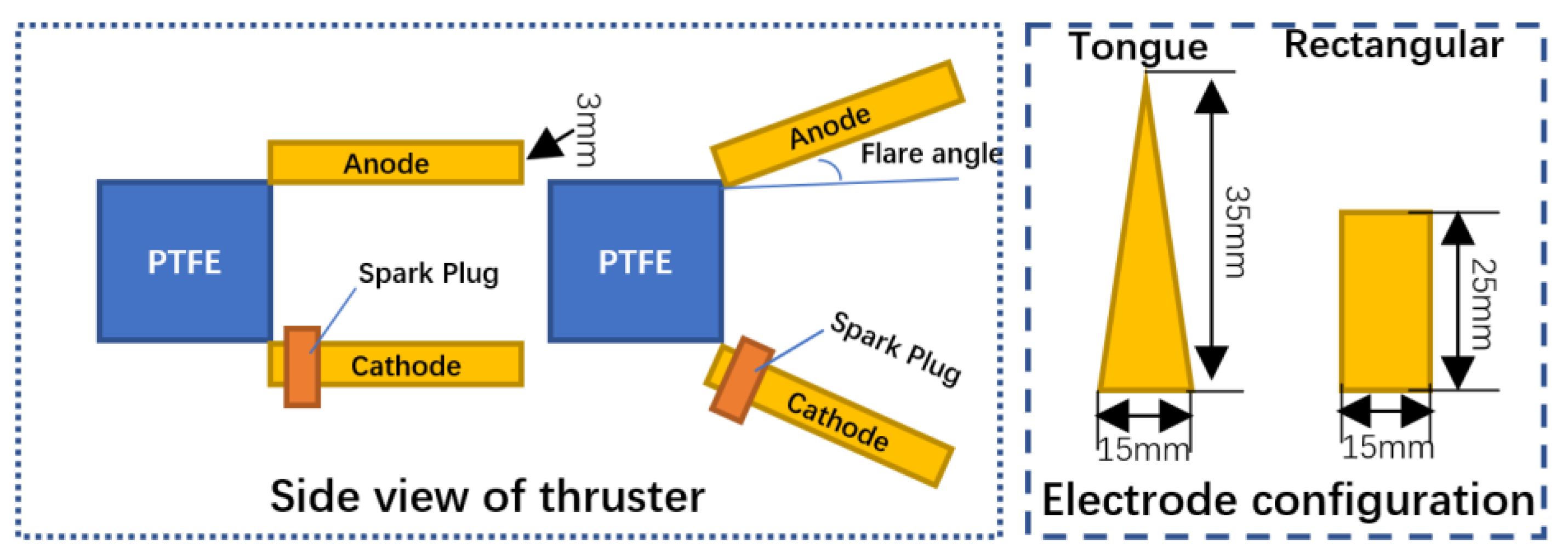

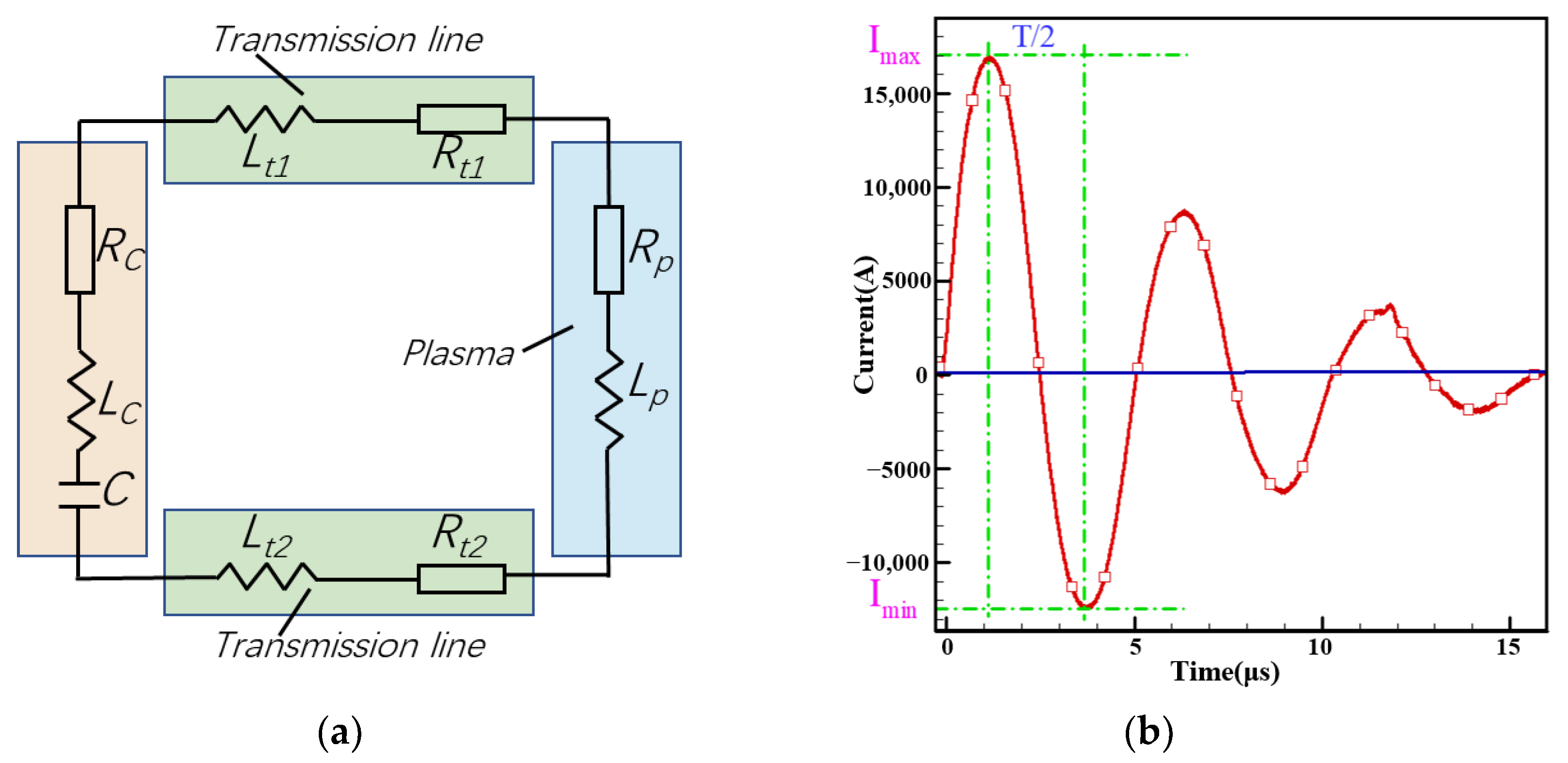
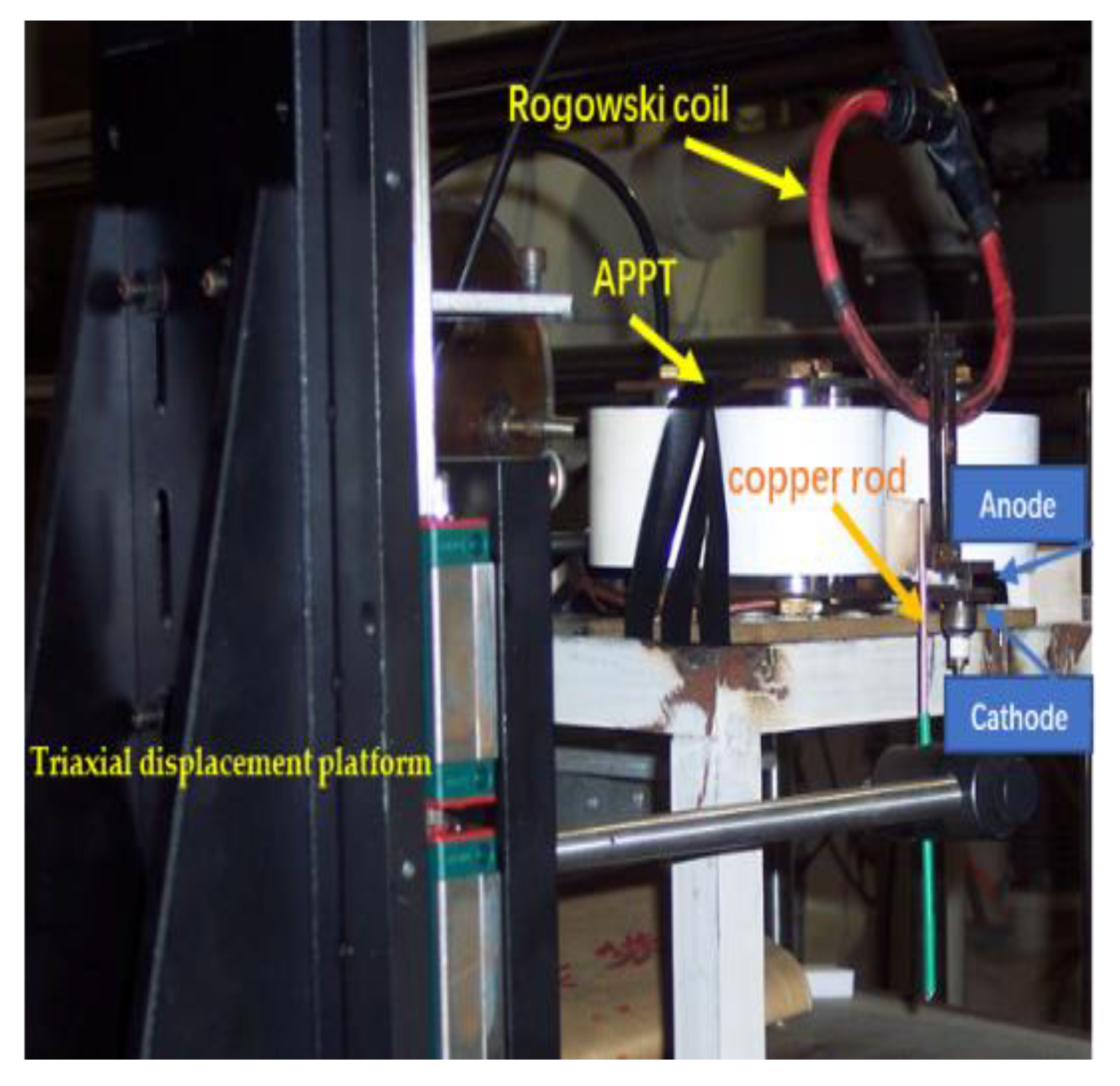

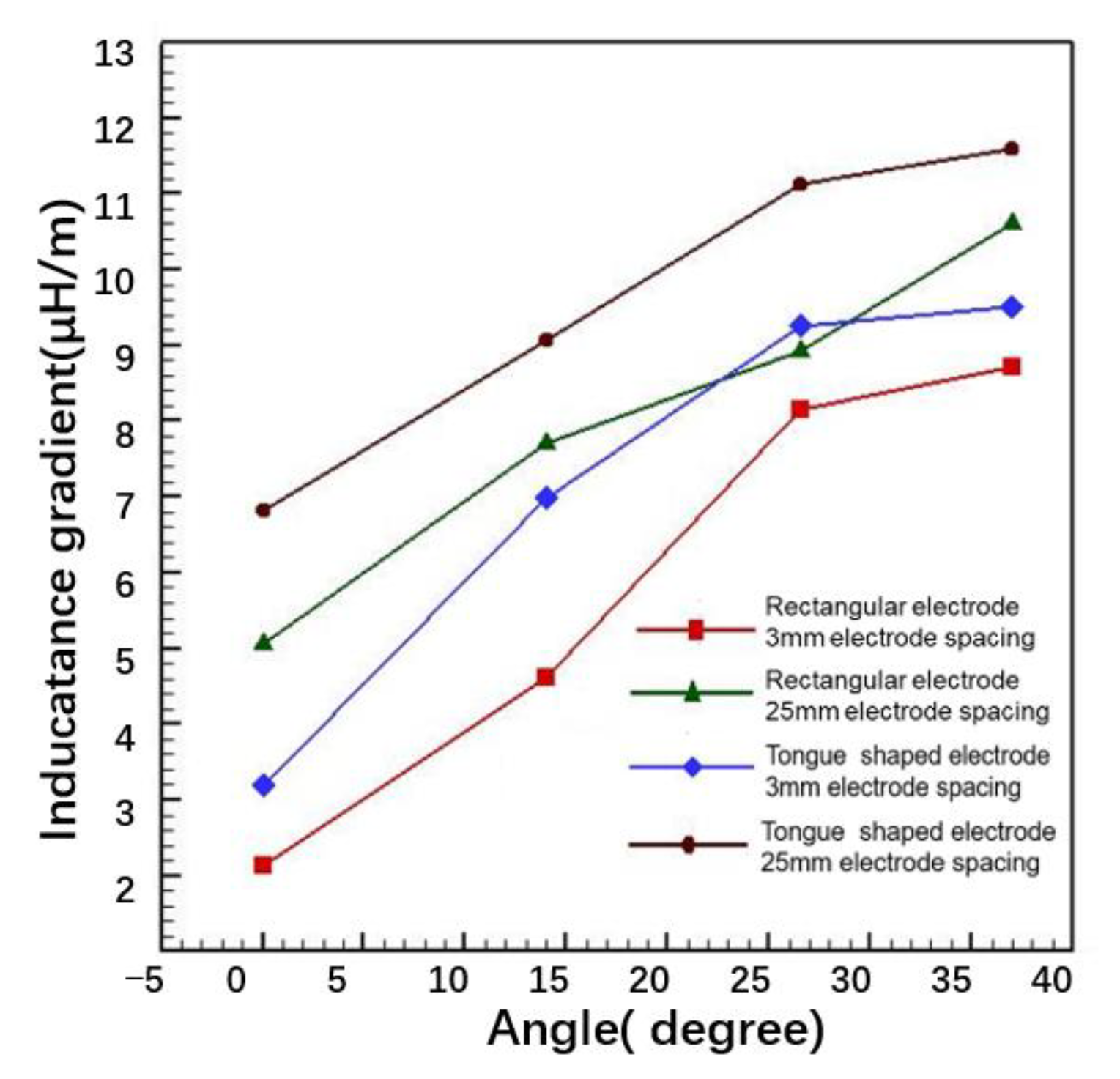

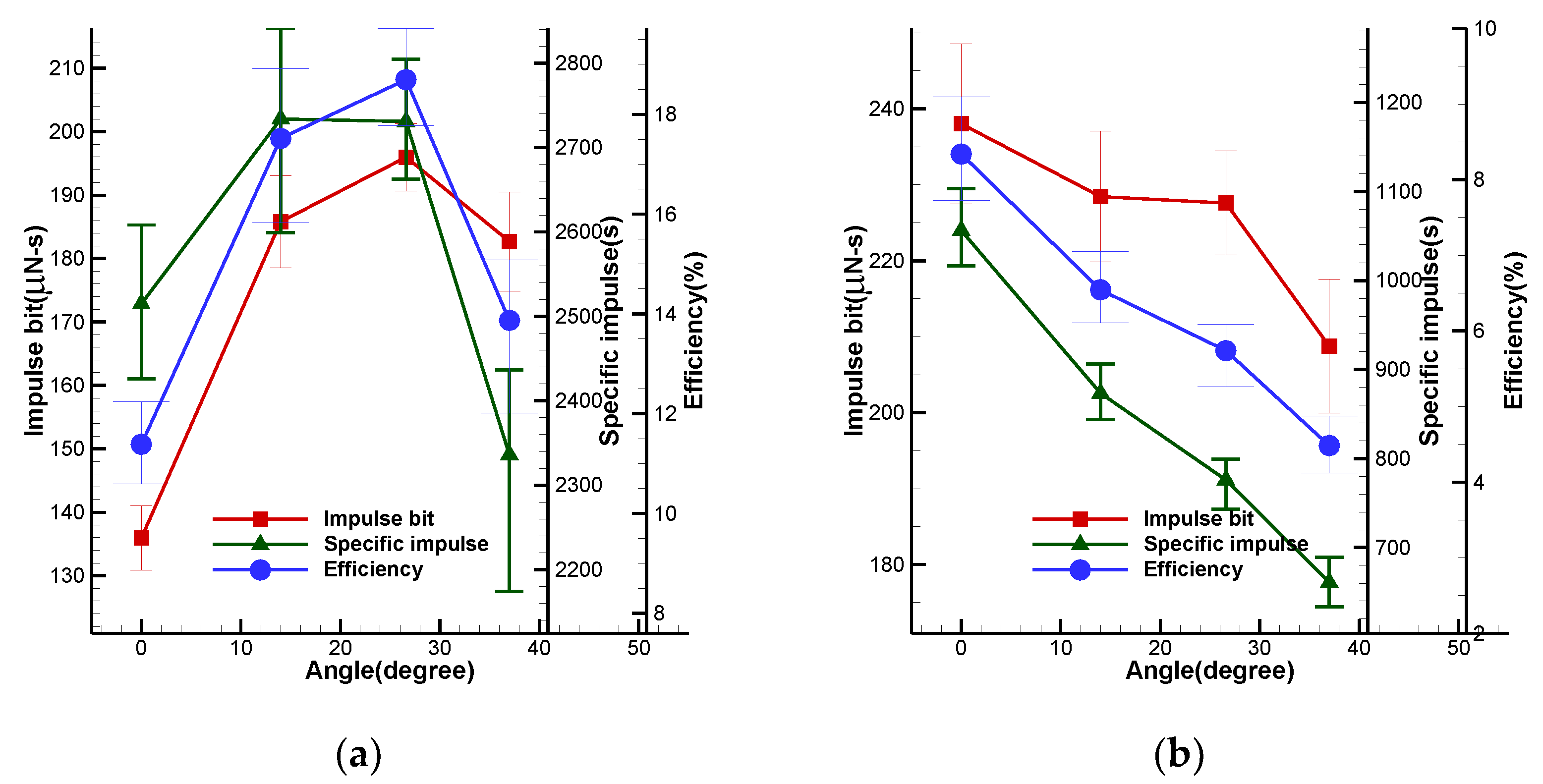
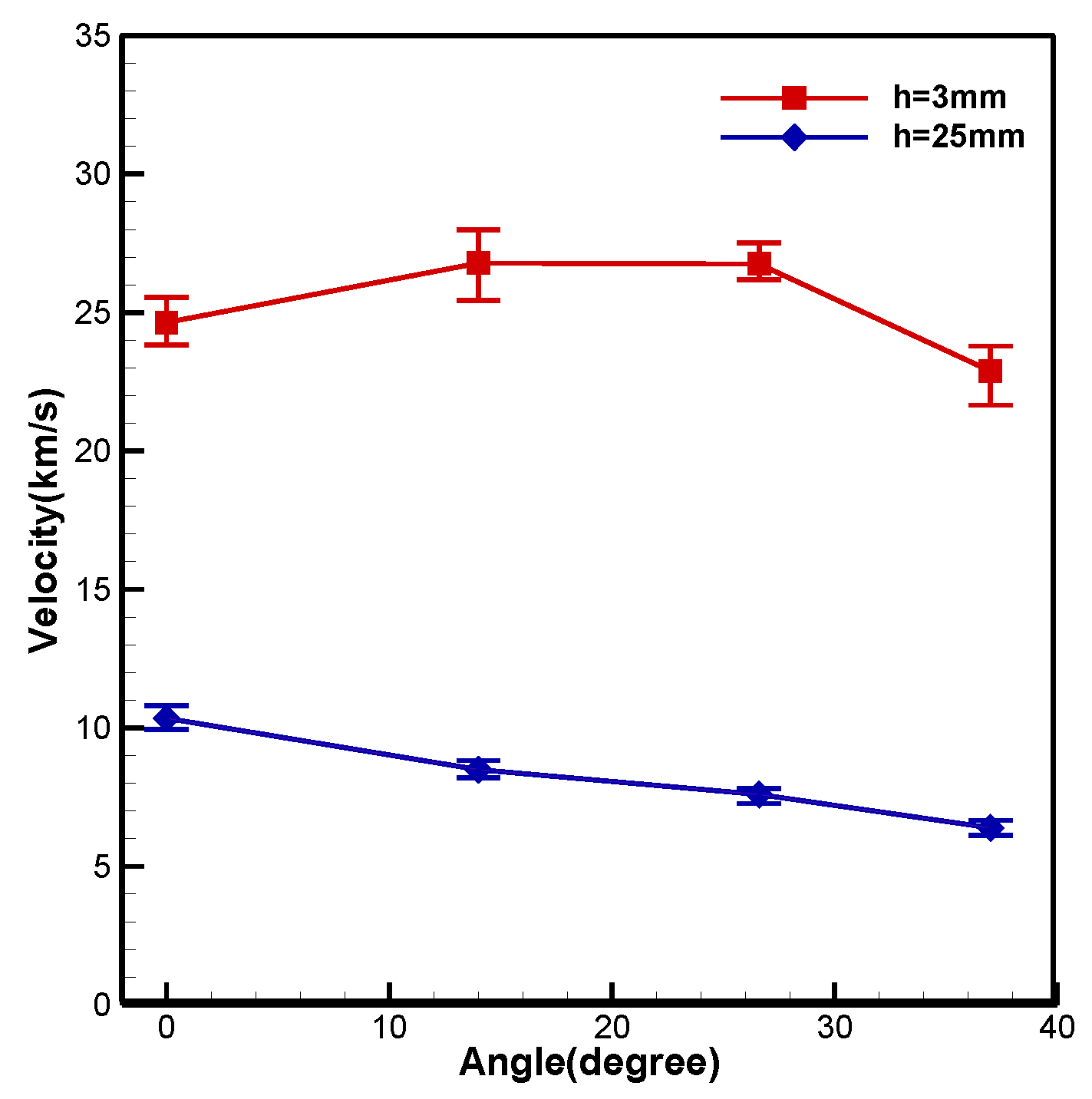



| Electrode Spacing | Flare Angle | Imax [KA] | Leq [nH] | Req [mΩ] | Ψ [A2·s] | ηtr [%] |
|---|---|---|---|---|---|---|
| 3 mm | 0° | 17.06 | 56.92 | 8.61 | 884.17 | 68.73 |
| 14° | 15.83 | 61.79 | 15.55 | 509.29 | 68.71 | |
| 26.6° | 14.35 | 64.63 | 15.79 | 487.02 | 60.86 | |
| 37° | 13.18 | 64.58 | 16.12 | 456.12 | 57.65 | |
| 25 mm | 0° | 15.23 | 64.52 | 20.03 | 446.15 | 79.71 |
| 14° | 14.96 | 64.76 | 21.52 | 358.09 | 79.24 | |
| 26.6° | 14.43 | 64.93 | 24.48 | 319.54 | 78.97 | |
| 37° | 13.11 | 64.86 | 26.25 | 274.79 | 72.81 |
| Electrode Spacing | 0° | 14° | 26.6° | 37° |
|---|---|---|---|---|
| 3 mm | 5.52 ± 0.42 | 6.94 ± 0.34 | 7.32 ± 0.37 | 7.98 ± 0.28 |
| 25 mm | 22.99 ± 0.33 | 26.69 ± 0.24 | 29.93 ± 0.42 | 32.23 ± 0.25 |
| Electrode Spacing | Flare Angle | Imax [KA] | Leq [nH] | Req [mΩ] | Ψ [A2·s] | ηtr [%] |
|---|---|---|---|---|---|---|
| 3 mm | 0° | 21.06 | 51.89 | 12.26 | 968.76 | 80.23 |
| 14° | 19.05 | 53.12 | 12.41 | 870.24 | 83.65 | |
| 26.6° | 17.53 | 54.07 | 12.98 | 789.9 | 80.81 | |
| 37° | 17.26 | 56.65 | 14.69 | 649.1 | 83.47 | |
| 25 mm | 0° | 20.1 | 55.41 | 19.70 | 855.01 | 88.59 |
| 14° | 18.35 | 58.23 | 19.92 | 712.57 | 90.04 | |
| 26.6° | 16.1 | 60.68 | 21.27 | 551.98 | 86.78 | |
| 37° | 16.2 | 66.84 | 22.91 | 499.54 | 80.48 |
| Electrode Spacing | 0° | 14° | 26.6° | 37° |
|---|---|---|---|---|
| 3 mm | 6.45 ± 0.36 | 8.71 ± 0.24 | 9.022 ± 0.23 | 8.17 ± 0.44 |
| 25 mm | 27.23 ± 0.28 | 30.94 ± 0.14 | 34.67 ± 0.32 | 41.25 ± 0.22 |
Publisher’s Note: MDPI stays neutral with regard to jurisdictional claims in published maps and institutional affiliations. |
© 2022 by the authors. Licensee MDPI, Basel, Switzerland. This article is an open access article distributed under the terms and conditions of the Creative Commons Attribution (CC BY) license (https://creativecommons.org/licenses/by/4.0/).
Share and Cite
Zhang, R.; Tian, Z.; Xi, W.; He, D. Discharge Characteristics and System Performance of the Ablative Pulsed Plasma Thruster with Different Structural Parameters. Energies 2022, 15, 9389. https://doi.org/10.3390/en15249389
Zhang R, Tian Z, Xi W, He D. Discharge Characteristics and System Performance of the Ablative Pulsed Plasma Thruster with Different Structural Parameters. Energies. 2022; 15(24):9389. https://doi.org/10.3390/en15249389
Chicago/Turabian StyleZhang, Rui, Zhiqiang Tian, Wenxiong Xi, and Dongjing He. 2022. "Discharge Characteristics and System Performance of the Ablative Pulsed Plasma Thruster with Different Structural Parameters" Energies 15, no. 24: 9389. https://doi.org/10.3390/en15249389





